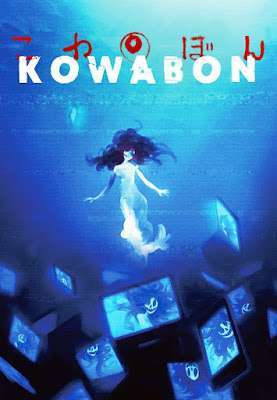Director: Kazuma Taketani
Screenplay: Hiromu Kumamoto
Viewed in Eastern with English Subtitles
A micro-series, thirteen episodes
which will be three minutes lengthy each, nevertheless in characteristic of absurdist comedy as many I
own viewed are, right here’s a dread series, the likes of which will be turning into as
general too in Eastern animation as bite-sized size series. This one as effectively
is terribly worthy an honest experiment too with is rewarding. Your complete episodes
are primarily primarily based fully upon a portion of technology, be
it a video name to cell telephones, being jumpy by a female ghost with
malicious intent, something which is terribly general in Eastern pop tradition.
The total series has episodes
ending predictably, the place lastly a wholesome launch becomes creepier, until
lastly no person ends their myth effectively, including the fellow in his on-line point to
slow sufficient to bolt to the haunting achieve of the outdated episode earlier than him. Japan
in its fashioned tradition has been documenting how ghosts would hold-out out
technology for decades now, and it continually feels pure from an outsider’s
perspective because a) the frequency to which this sort of contemporary country shows it yet
is composed connected to its past, which approach that the supernatural and folklore own
no longer been alienated, and b) there’s a flawlessness in how, if there ever change into as soon as
something cheesy just a few premise, it’d be for a shaggy dog myth except you purchased right here all the draw thru
a sinful work, even as more continually than no longer it’s taken more seriously. Their ghosts
and monsters are no longer as doubtless to be gigantic, whereas you happen to are going off the last be conscious
dread motion photos in this residence respect Ringu
(1998) or Pulse (2001), so
nothing is out of characteristic or gauche regarding the mix of the 2 attributable to
cohabitation. As worthy of it’s how matter-of-truth these reports are, that the
ghosts were continually there, and likewise right here we never gain the feeling of these
episodes having to reintroduce the female ghost, nevertheless that right here is continually going
to happen. Her existence isn’t even outlined, and he or she is good a malicious
figure inserting over the sphere.
The reports are surely spooky
scares, more broadly relaxing scary than the atmosphere of those motion photos mentioned,
nevertheless it absolutely is attention-grabbing the selections taken even for three minute narratives. A
video name with other folks new to the tech, the place it’s the caller jumpy. The
video camera at a front door, the place one other accomplishing is other folks looking out to sell
you insurance. Selfies and on-line blogging of 1’s self, which conjures up self
respect and that, even in the nineties lengthy earlier than relatively just a few this technology
existed, Satoshi Kon’s debut film Finest Blue (1997) and the series Serial Experiments Lain (1998) own
stayed linked supreme for the phobia of a doppelganger who claims to be you being
on-line. A sort of why Kowabon works
is that, even as the point to throws warning to the wind and embraces the jolts and
unsuitable having a gawk ghosts of a jumpy residence slump, it composed resonates with the phobia
that even when technology is in opposition to us, when it malfunctions or supreme in short
flickers, there is sufficient room to induce a anxiety.
Additionally, now in the end, the reports for
your complete ones which will be pure scares, some own more to them to read between the
traces. The girl at odds alongside with her have confidence on-line self, and a commenter who is
doubtless ghost, who withers away, as worthy in a location to be held as a observation on
depression and the risks of on-line self portray. A wannabe idol, filming a
dance video in the park, who is literally corrupted by her have confidence doubt and
self-destructs. That video name with other folks mutated into only one, a ghost,
judging their son for no longer calling them earlier than. Eerie icing on these truffles.
The change factor of mark is that
the series is though-provoking with rotoscoping. Ending in the credit ranking with
in the help of-the-scenes photos, the production filmed stay action performances at
locations first after which though-provoking over them. It has a extraordinarily excellent spend right here
as, alongside no longer being as potentially time constraining to animate, it gives
accurate vital spend because it approach Kowabon
does no longer own to rely on low-price having a gawk digital results. As an change, it ought to spend the
animation for the supernatural dispute with a stylistic flair. It manages,
immensely so, to balance the definite actuality of actors onscreen with the more
fantastical shots from the dearth of the constraints with animation fully.
So, which means that for me, right here is
as worthy an experimental series too which succeeded with this opinion. Attributable to the
slightness of the episodes, it’s complicated to jot down in increased component about
work which does no longer own relatively just a few time in three minutes to work with. The
aesthetics nevertheless assemble a big portion of the experience, a extraordinarily multicoloured
disagreement to its fights which contrasts the dread with an deliberately
cartoonish supernatural tone, in particular when the discontinuance credit ranking is characteristic to a
bouncy J-pop track and lovely dread figures bouncing alongside. Infrequently it even
feels respect a Superflat pop collage, if Takashi
Murakami’s work had long gone for more spookiness with bouncing skulls, its
plasticity in opposition to the reveal actors and locations though-provoking over compelling. In
one other timeline, we will own easily had a sequel series with even longer
episode, if only beneath fifteen minutes, and separate narratives. On this
timeline, Kowabon works effectively by
itself.



